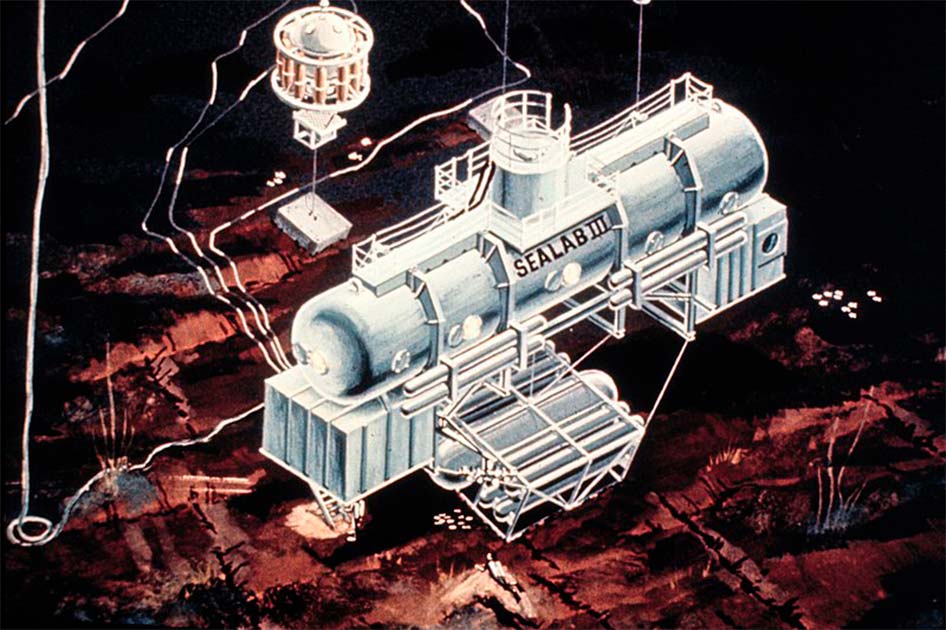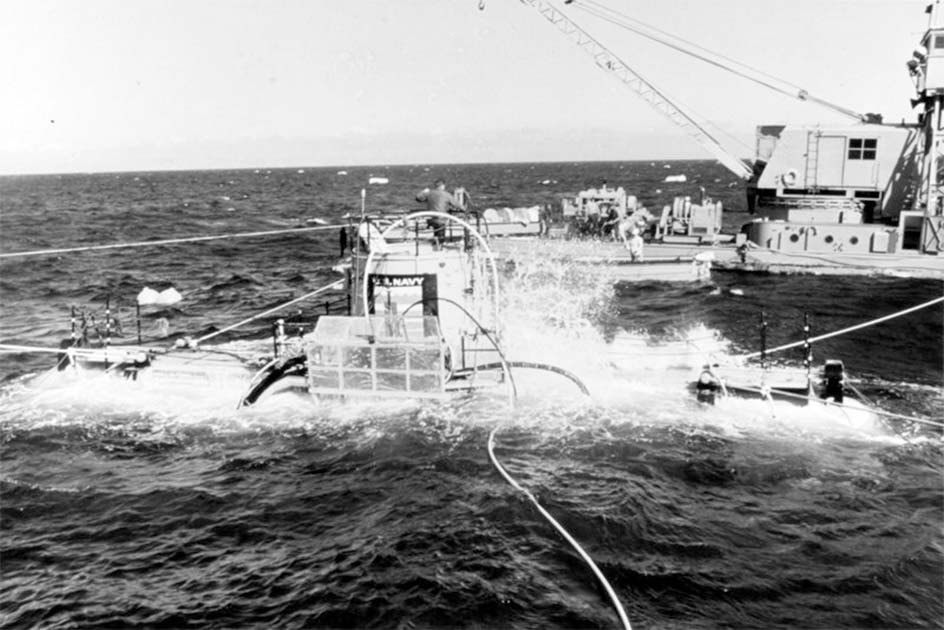Around 71% of the Earth’s surface is covered by the ocean. Which is a lot.
Of that water, only around 20% has been mapped using high-resolution bathymetry (underwater topography) and less than 5% has been explored through deep-sea exploration. In the 1960s the human urge to explore the ocean led to the SEALAB experiment.
These were a series of remarkable underwater habitats aimed at unlocking the mysteries of prolonged underwater living and aiding in the exploration of the oceans. However, the isolated environment and extreme conditions took a heavy toll on the psyche of those involved, and the project was ultimately shut down.
What went wrong? Let’s find out.
Human Experimentation Beneath the Waves
It often feels like the 1960s was the golden age of weird science. Conceived by the visionary George F. Bond, the SEALAB project aimed to simulate conditions for prolonged living and working in the ocean’s depths, similar to the environments experienced by deep-sea divers. By immersing teams of aquanauts in pressurized habitats on the ocean floor, scientists hoped to unravel the physiological and psychological effects of prolonged underwater existence.
The SEALAB project saw three different iterations between 1964 and 1969, with each experiment being more advanced than the last. However, the project also ran into constant hurdles including malfunctions, budget constraints, and even accusations of sabotage. Let’s take a look at each iteration and see where things went wrong.
SEALAB I
The first version of the habitat, SEALAB I, was certainly the roughest around the edges and the aquanauts faced a series of unexpected challenges and setbacks. While the habitat was designed to simulate conditions for prolonged underwater living, the reality proved to be far more demanding than anticipated.

SEALAB I was deployed off the coast of Bermuda in 1964 and consisted of some slightly janky engineering. It consisted of two converted steel flotation chambers held in place by repurposed railroad car axles, with a living space for aquanauts stationed at depths of up to 192 feet (58 meters). The habitat was connected to the surface by umbilical cords, which supplied the divers with compressed air, power, and communication.
Maintaining temperature control quickly proved to be a major problem and the aquanauts complained of excessively cold temperatures due to inadequate insulation. The constant exposure to frigid temperatures led to discomfort and reduced the efficiency of their work. Additionally, elevated levels of humidity caused condensation to form, further exacerbating the already uncomfortable living conditions.
Adding to the aquanauts’ distress was the fact that communication between the surface and the aquanauts was often compromised, leaving them feeling isolated and cut off from immediate assistance. The umbilical cords, which provided the divers with essential resources, frequently malfunctioned, forcing the aquanauts to endure extended periods without a reliable supply of power or air.
These problems added to the psychological strain of living in the confined and isolated environment which took its toll on the aquanauts, leading to tension and emotional distress. While the experiment was supposed to run for three weeks, it was cut short after just 11 days.
- Project Azorian: Did Howard Hughes Try to Steal a Russian Sub?
- Military Marine Mammals: A History of Exploding Dolphins
At the time its premature termination was put down to an approaching tropical storm. However, some suspect the true reason for the project’s premature shutdown was due to the psychological state of the four divers.
This isn’t to say the original SEALAB was seen as a failure. The difficulties faced during SEALAB I highlighted the need for further research and development to improve the design and functionality of underwater habitats, paving the way for subsequent iterations of the SEALAB experiment.
SEALAB II
Just a year later SEALAB II was deployed off the coast of California. The aim was to build upon the lessons learned from the challenges of SEALAB I. This second iteration of the experiment introduced several improvements to enhance the living conditions and operational capabilities of the aquanauts.
It was a major step up. It was around twice as large as the original which provided the aquanauts with more space to move around and conduct their experiments, alleviating the feelings of confinement experienced during the previous mission.
The habitat also incorporated several quality-of-life upgrades. The deck included heating coils designed to stave off the constant chill experienced by the original aquanauts and air conditioning was added to reduce the crippling humidity. It even had hot showers and a fridge.
Additionally, SEALAB II incorporated better insulation to address the issue of temperature control. The new design effectively mitigated the cold temperatures, creating a more comfortable environment for the aquanauts and enabling them to focus on their tasks with greater ease.
Communication systems were also upgraded in SEALAB II, ensuring more reliable and consistent contact with the surface. This enhancement enhanced safety and allowed for more effective coordination between the aquanauts and the support team above.

Despite these improvements, SEALAB II still faced its fair share of challenges, including leaks and maintenance issues. Most disturbingly, there were accusations of sabotage. It has been claimed that during the mission a diver intentionally severed the umbilical cord that connected the habitat to the surface. If true, this deliberate act of sabotage jeopardized the lives of the aquanauts.
Despite these challenges, SEALAB II successfully extended the duration of the experiment to 15 days, providing valuable data on the physiological and psychological effects of prolonged underwater habitation. In fact, one aquanaut (and former astronaut) Scott Carpenter stayed submerged for a record 30 days.
SEALAB III
The project ended in 1969 with the final and most ambitious installment, SEALAB III. Building upon the lessons learned from the previous missions, SEALAB III aimed to push the boundaries of underwater living and scientific exploration by repurposing the SEALAB II habitat and placing it in water three times deeper.
- Sudden Silence: What Happened to the Pakistani Submarine Ghazi?
- Donald Crowhurst and his Fatal Race Round the World
The most notable advancement in SEALAB III was the introduction of multiple interconnected chambers. This design provided the aquanauts with separate areas for living, working, and conducting experiments, allowing for increased efficiency and specialization of tasks.
Of all the SEALAB iterations this one faced the most severe setbacks. An 18-month delay meant that when the habitat was finally lowered into the ocean shortcuts were made. Shortcuts that came with deadly consequences.

SEALAB III was supposedly to be the most advanced and sophisticated experiment yet (OAR/National Undersea Research Program (NURP); U.S. Navy / Public Domain)
Not long after the habitat had been submerged it was found that a poorly sized neoprene seal was causing a potentially dangerous hydrogen leak. Rather than bringing the habitat back to the surface, which would have caused yet more delays, several of the divers volunteered to repair the leak underwater.
The process took over 20 hours and the divers had to take amphetamines to stay awake. During the repairs aquanaut Berry L. Cannon died. It was later discovered his rebreather was faulty, causing him to breathe in his own carbon dioxide.
These initial setbacks plus the prolonged duration of the mission—scheduled for three weeks—exacerbated the physical and psychological strain on the aquanauts. Isolation, high pressures, and the demanding conditions of living underwater contributed to increased stress levels and decreased morale.
Ultimately, SEALAB III was prematurely terminated after just 12 days due to a series of critical failures and concerns over the deteriorating mental and physical well-being of the aquanauts. But the controversy wasn’t over yet.
According to John Piña Craven, the U.S. Navy’s head of the Deep Submergence Systems Project, SEALAB III was also the victim of a saboteur. He claimed that while the surviving divers were undergoing their week-long decompression someone on the command barge floating above SEALAB III attempted to sabotage their air supply.

SEALAB III was beset by suggestions of sabotage, as well as other problems (US Navy / Public Domain)
This led to a guard being posted outside. A suspect was identified by a Navy psychiatrist but never prosecuted. Craven believes the U.S. Navy was hoping to avoid an even bigger scandal.
Life in the Depths
The SEALAB experiment stands as a testament to humanity’s unwavering spirit of exploration and the relentless pursuit of knowledge. From the initial challenges faced aboard SEALAB I to the advancements made in SEALAB II and III, these missions pushed the boundaries of underwater habitation and offered invaluable insights into the physiological and psychological effects of living beneath the waves.
Despite the difficulties encountered and the premature terminations, the SEALAB experiments paved the way for future advancements in underwater exploration and habitat design. They serve as a reminder of the bravery and determination of those who ventured into the depths, seeking to unravel the mysteries of the underwater world and expand our understanding of human capabilities in extreme environments.
Top Image: SEALAB II in 1965. Source: OAR/National Undersea Research Program (NURP); U.S. Navy / Public Domain.